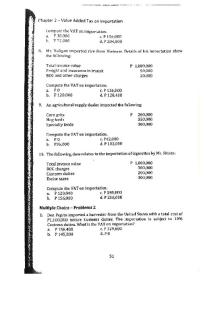Chapter 3 - Lecture notes 3 PDF

| Title | Chapter 3 - Lecture notes 3 |
|---|---|
| Author | Isabella Manlapaz |
| Course | Organic Chemistry I |
| Institution | Tarleton State University |
| Pages | 3 |
| File Size | 42.5 KB |
| File Type | |
| Total Downloads | 103 |
| Total Views | 192 |
Summary
Course was instructed by Dr. Rajani Srinivasan for a 6 week summer course....
Description
Chapter 3: Acids and Bases An Introduction to Organic Reactions and their Mechanisms
Acid-Base Reactions Bronsted-Lowry Acids and Bases Bronsted-Lowry acid-base reactions involve the transfer of protons Acid- donates or loses a proton Base- accepts or removes a proton Example: H2O + H-Cl -> H3O + ClH3O (hydronium ion) – strongest acid that can exist in water HO (hydroxide ion)- strongest base that can exist in water
Lewis Acids and Bases Lewis acids are electron pair acceptors Lewis bases are electron pair donors Example: Cl – H + NH3 -> Cl - + H—NH3
Electrophiles and Nucleophiles
Because carbocations are electron-seeking reagents, chemists call them electrophiles Electrophiles seek electrons (E+) All Lewis acids are electrophiles
Carbanions are Lewis bases (Nu-) pKa = -log [Ka] Keq = equilibrium constant Keq = [c][d]/[a][b]
Large value of Ka = strong acid Small value of Ka = weak acid Larger value of pKa = weak acid Smaller value of pKa = strong acid Example CH3CO2H > CF3CO2H > HCl pKa= 4.75 -
pKa= 0
pKa= 7
The stronger the acid, the weaker its conjugate base The weaker the acid, the stronger the base The stronger the H-X bond, the weaker the acid
Example: HF > HCl > HBr > HI Increasing acidity
The Effect of Hybridization H-C ≡ C-H
C=C
C—C
pKa = 25
pKa = 44
pKa = 50
50% s character
33.3% s character
25% s character
sp
sp2
sp3
More s character means electrons of anion will be lower in energy and anion will be more stable.
Relative Acidity of Hydrocarbons H-C ≡ C-H
>
C=C
>
C—C
>
H-C ≡ C-H
Relative Basicity of Hydrocarbons C—C
>
C=C
Inductive Effects
Electronic effects transmitted through bonds The inductive effect of a group can be electron donating or electron withdrawing Inductive effects weaken as the distance from the group increases
Energy changes
The two fundamental types of energy are kinetic and potential energy Kinetic energy = ½ mv2 Potential energy = mgh
Potential energy is stored energy Chemical energy is a form of PE More PE > less stable Less PE > more stable
Potential Energy and Covalent Bonds Atoms and molecules possess potential energy—often called chemical energy—that can be released as heat when they react. Δ G = -RT ln Keq R= gas constant (8.314 J K-1) ΔG=ΔH-TΔS Δ H enthalpy- total energy in system Δ S entropy- disorder in system - Δ H makes Δ G negative...
Similar Free PDFs

Chapter 3 - Lecture notes 3
- 1 Pages

Chapter 3 - Lecture notes 3
- 30 Pages

Chapter 3 - Lecture notes 3
- 6 Pages

Chapter 3 - Lecture notes 3
- 6 Pages

Chapter 3 - Lecture notes 3
- 45 Pages

Chapter 3 - Lecture notes 3
- 5 Pages

Chapter 3 - Lecture notes 3
- 4 Pages

Chapter 3 - Lecture notes 3
- 4 Pages

Chapter 3 - Lecture notes 3
- 4 Pages

Chapter 3 - Lecture notes 3
- 3 Pages

Chapter 3 - Lecture notes 3
- 3 Pages

Chapter 3 - Lecture notes 3
- 24 Pages

Lecture Notes Chapter #3
- 3 Pages

Chapter 3 Lecture Notes
- 4 Pages

Chapter 3 Lecture Notes
- 80 Pages
Popular Institutions
- Tinajero National High School - Annex
- Politeknik Caltex Riau
- Yokohama City University
- SGT University
- University of Al-Qadisiyah
- Divine Word College of Vigan
- Techniek College Rotterdam
- Universidade de Santiago
- Universiti Teknologi MARA Cawangan Johor Kampus Pasir Gudang
- Poltekkes Kemenkes Yogyakarta
- Baguio City National High School
- Colegio san marcos
- preparatoria uno
- Centro de Bachillerato Tecnológico Industrial y de Servicios No. 107
- Dalian Maritime University
- Quang Trung Secondary School
- Colegio Tecnológico en Informática
- Corporación Regional de Educación Superior
- Grupo CEDVA
- Dar Al Uloom University
- Centro de Estudios Preuniversitarios de la Universidad Nacional de Ingeniería
- 上智大学
- Aakash International School, Nuna Majara
- San Felipe Neri Catholic School
- Kang Chiao International School - New Taipei City
- Misamis Occidental National High School
- Institución Educativa Escuela Normal Juan Ladrilleros
- Kolehiyo ng Pantukan
- Batanes State College
- Instituto Continental
- Sekolah Menengah Kejuruan Kesehatan Kaltara (Tarakan)
- Colegio de La Inmaculada Concepcion - Cebu
